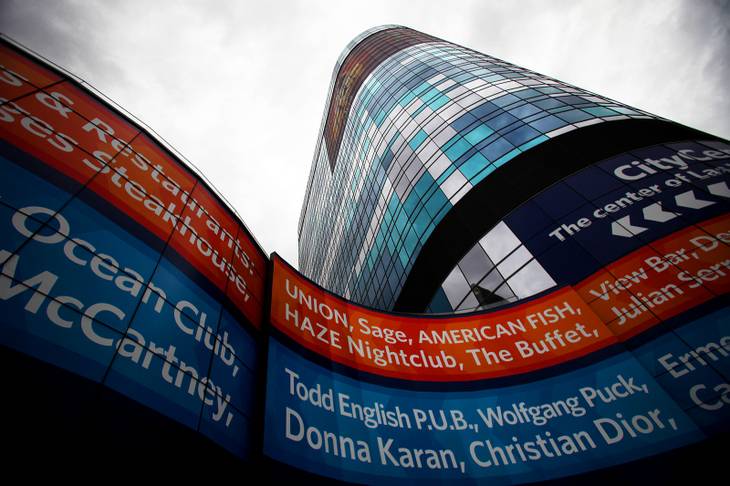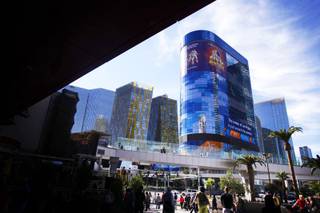Related stories
- Judge in Harmon case refuses to allow attorneys to place blame (3-13-2012)
- A quake could topple the Harmon, engineer testifies in Strip case (3-13-2012)
- Harmon Tower demolition hearing set for March (12-14-2011)
- Subcontractors fight Harmon demolition plan (11-29-2011)
- CityCenter seeks to collect evidence at Harmon before implosion (10-27-2011)
- MGM Resorts seeks to demolish CityCenter’s Harmon Hotel (8-15-2011)
- MGM Resorts seeks to demolish CityCenter’s Harmon Hotel (8-15-2011)
Don’t look for a quick decision on whether the Harmon hotel tower in Las Vegas can be imploded because of construction defects and safety concerns.
In a Clark County District Court lawsuit over the defects and unpaid invoices from a handful of contractors linked to the defects, Judge Elizabeth Gonzalez decided Wednesday that four days of hearings this week on CityCenter’s implosion request for its Harmon building aren’t enough.
With attorneys spending more time than anticipated questioning and cross-examining witnesses, Gonzalez on Wednesday set two more days of hearings on April 18 and April 19.
She also gave CityCenter attorneys more work to do, saying they could take a deposition of a previously undeposed key witness for CityCenter general contractor Perini Building Co.
Gonzalez also said she needs to see more briefs or hear more arguments on some issues unique to the case, particularly involving the request to implode the uncompleted 26-story hotel tower built at a cost of $279 million before work was halted in 2010.
These unique issues include whether, should the Harmon be imploded, a jury considering the construction-defect claims during a trial next year would assume that in fact there were substantial defects since the building had been demolished. The jury would also be deprived of the opportunity to tour the Harmon in its as-built condition and may have a hard time understanding its size and the extensive amounts of concrete and steel used to build it, attorneys said.
Another issue is ''extrapolation,'' or whether the identification of defects in a small sampling of the building can be extrapolated to assume similar defects exist in similar components throughout the structure. The Harmon, experts testified, has an estimated 400 columns and 600 shear walls (walls designed to withstand earthquake forces), yet just 5 percent of its structural components have been tested.
The final additional issue Gonzalez wants more information on is the ''economic waste'' theory, which could limit damages for CityCenter.
''You are destroying property that otherwise could be repaired,'' Gonzalez told CityCenter attorneys on Wednesday.
During Wednesday’s Day Three of what had been planned as four days of hearings this week, Perini disputed contentions that the Harmon should come down because it could collapse during an earthquake.
Perini claims design defects contributed to problems at the Harmon, but it and its witnesses acknowledge there are some construction defects or what Perini calls ''nonconforming work.''
In fact, Perini is in litigation with some subcontractors over their role in the debacle.
Nevertheless, Perini attorney George Ogilvie told Gonzalez on Wednesday that, ''In fact it is safe.''
''It can be repaired to be made code compliant,'' he said before calling as a witness local structural engineer Steve Schiller of John A. Martin & Associates Inc.
Schiller said a temporary, $2 million shoring up of the building could be accomplished in two months or less and this should resolve concerns about it collapsing in an earthquake.
CityCenter has been ordered by Clark County to abate the earthquake-collapse danger by either repairing the Harmon or demolishing all or part of it; and CityCenter has chosen the complete demolition route as the surest and most efficient way to deal with the problem.
Schiller is the key witness CityCenter will now have a chance to depose; attorneys for CityCenter — half owned by MGM Resorts International — no doubt will have plenty of questions for him.
That’s because Schiller’s conclusions about the safety of the Harmon, and how long it would take to repair the building if repairs are possible, are markedly different than those of CityCenter’s hired engineer.
The problems at the Harmon surfaced in 2008 and generally involve missing or improperly installed and connected reinforcing steel embedded in concrete walls, columns and beams.

